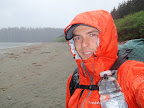 I’ve been thinking about doing the CDT since the middle of my PCT hike in 2007. I was in central California, staying at a trail angel’s house, and they had a copy of one of the guidebooks for the CDT laying about. Oh, as an aside, a trail angel is simply someone who helps long distance hikers along the way. On the PCT, I was able to stay at quite a few people’s homes, occasionally I met people along the trail that offered me food, heck even people that I got a ride from qualify as trail angels in my book 🙂 Anyways, I read the guidebook and thought to myself that a CDT adventure sounded quite nice.
I’ve been thinking about doing the CDT since the middle of my PCT hike in 2007. I was in central California, staying at a trail angel’s house, and they had a copy of one of the guidebooks for the CDT laying about. Oh, as an aside, a trail angel is simply someone who helps long distance hikers along the way. On the PCT, I was able to stay at quite a few people’s homes, occasionally I met people along the trail that offered me food, heck even people that I got a ride from qualify as trail angels in my book 🙂 Anyways, I read the guidebook and thought to myself that a CDT adventure sounded quite nice.
I’ve set a range of time for when I want to start the CDT. June 15th – July 1st is my approximate start date. I’ll start sooner if snow conditions in the Rockies permit, or later if they don’t. Counting back from there, I have a lot of things to get done! The main thing to figure out is how to get food along the way. Generally, I’d like to start any section of the hike with about a weeks worth of food on my back. That seems to be the line between having enough food and having a backpack that is too heavy 🙂 Lots of people choose to pre-pack all their food and then have someone at home mail it to them in towns along the way. That way they arrive in town, go to the post office, pick up a food parcel, and then they can hike on. This has not been my choice because of two factors: 1) I don’t have an obvious way to get things mailed to me (Canadian Customs is a serious “wild card”), and 2) I am incapable of guessing what kind of food I’ll want as I go along. Things that seem so tasty beforehand become totally unpalatable within a week. Imagine making 5 months worth of food and hating it all within 2 weeks. That’s a lot of wasted/hated food.
There is a wonderful woman named Yogi who wrote a town/resupply guide for the CDT. She has saved me an incredible amount of work by simply laying out the resupply options. What I’ve done is go through her book and identify towns approximately a week apart. Then I’ve decided whether I think I can buy food at grocery stores or convenience stores in the town, or if I’ll need to mail myself food. If I need to mail it to myself, I go backwards and figure out what’s the nearest previous town with a good grocery store, and then buy the supplies there and mail it forward. This all takes advantage of the wonderful US Postal Service, which lets you mail things to any post office via “General Delivery”. They’ll hold anything for anyone at any post office for up to 30 days if propery addressed.
This plan works for almost the entire length of the trail. I can either buy food directly in a town, or buy food and mail it to myself down the trail. There are a couple places where I’m going to have to pick up food in odd places, like random little resorts that happen to be near the trail and are kind enough to hold packages sent via UPS. There are some places where getting to town is a huge hitchhike, and others where the trail goes right through town.
 The other main trick I’ll be using, is to send a “bounce box” to myself. This is a box of things, mainly packs of maps and guidebooks, that I don’t want to carry the whole way, but will need to regularly replace. So I’ll send it a week or two of hiking down the trail, then pick it up at the Post Office, take out the maps I need, probably grab some batteries, charge some other batteries, top up my water purification supplies, etc. Then send it onwards to the next stop. The reason this is worthwhile to me is that the CDT tends to pass through very small towns. The chances of getting anything other than food is very minimal.
The other main trick I’ll be using, is to send a “bounce box” to myself. This is a box of things, mainly packs of maps and guidebooks, that I don’t want to carry the whole way, but will need to regularly replace. So I’ll send it a week or two of hiking down the trail, then pick it up at the Post Office, take out the maps I need, probably grab some batteries, charge some other batteries, top up my water purification supplies, etc. Then send it onwards to the next stop. The reason this is worthwhile to me is that the CDT tends to pass through very small towns. The chances of getting anything other than food is very minimal.
What other logistical issues do I have to sort out? Gear and maps are the biggest ones, I’ll post on those separately.







